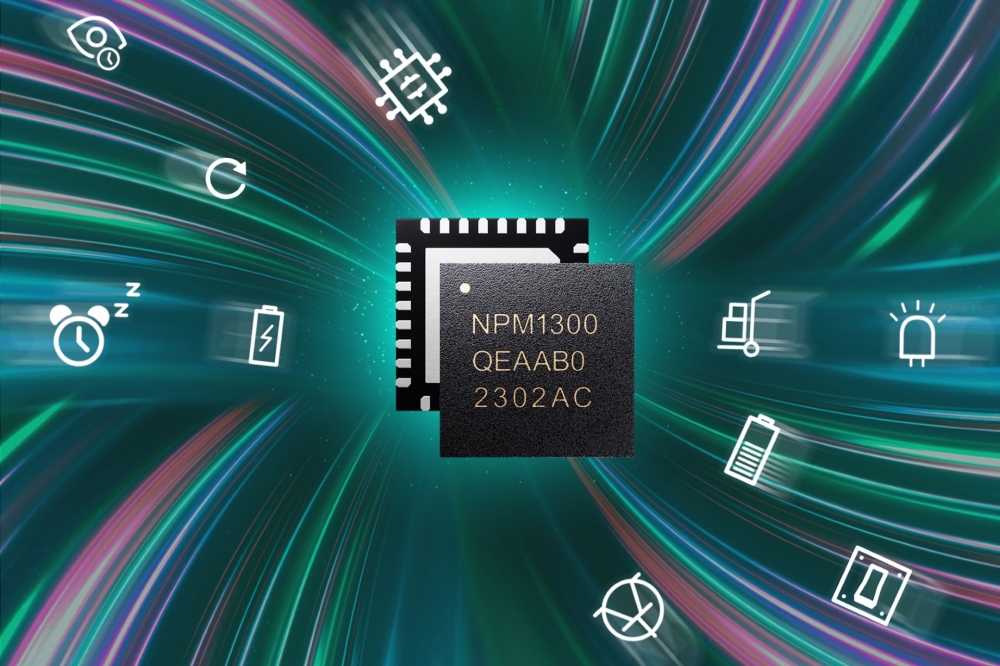Nordic Semiconductor launches multi-function nPM1300 Power Management IC

The nPM1300 PMIC simplifies power management system design by integrating essential functions into a compact package.
Nordic Semiconductor has launched its nPM1300™ Power Management IC (PMIC). With its two ultra efficient buck converters, two load switches/Low Drop Out voltage converters (LDOs) and integrated battery charging, the nPM1300 is ideal for battery-operated applications. It reduces an end-product’s Bill-of-Materials (BoM) by combining circuitry that typically requires five or more discrete components into a single chip. The launch is accompanied by the introduction of the nPM1300 Evaluation Kit (EK) and the nPM PowerUP PC app. The EK and the app make it simple for developers to evaluate, configure, and implement the nPM1300 PMIC without having to write any code.
The PMIC also brings unique system management features and accurate fuel gauging for low power wireless applications. The unique algorithm-based fuel gauge functionality of the nPM1300 uses voltage, current, and temperature monitoring for higher accuracy than voltage-based fuel gauges, while keeping the PMIC’s own power consumption considerably lower than coulomb counter-type fuel gauges. Nordic is the first company to achieve this balance between high accuracy and low power consumption, and it can’t be found in any competitive PMIC product.
“We’ve launched the nPM1300 to make it easy for developers to add a compact, optimized power management solution to their low power products - eliminating the need to design-in system management functions from scratch using five or six discrete components,” says Geir Kjosavik, Product Director – PMIC, Nordic Semiconductor. “And we’ve similarly removed the complexity of PMIC evaluation and development with the associated Evaluation Kit. With the kit and the nPM PowerUP app, developers can quickly set things up to minimize the power consumption of their application without the need to write any software.”
Compatibility with Nordic’s ultra low power wireless solutions
Developers using Nordic’s nRF52® and nRF53® Series, as well as the recently announced nRF54H20™ advanced wireless multiprotocol Systems-on-Chip (SoCs), will find the nPM1300 is the perfect match for their power management needs. The PMIC is also suitable for battery charging for applications based on the nRF9160™ SiP for cellular IoT, by using the PMIC’s unregulated output to power the nRF9160’s internal buck regulators.
Optimization for efficiency and compact size
The PMIC is optimized for maximum efficiency and compact size, and is configurable through an I2C-compatible Two Wire Interface (TWI). This interface enables easy access to configure a range of advanced system management functions, including integrated hard reset functionality from one or two buttons, accurate battery fuel gauging, system-level watchdog, power loss warning, and recovery from failed boot. These functions are typically implemented as discrete components in conventional designs, but with the nPM1300 they exist as on-chip functions.
Battery charging and thermal regulation
The nPM1300 PMIC operates from either a 4.0 to 5.5 V external power supply or a battery voltage down to 2.4 V. Two power rails are regulated by separate DC/DC buck converters that are configurable between 1.0 and 3.3 V and up to 200 mA maximum current. The other two power rails operate as load switches—switching currents of up to 100 mA from external sources—but can also perform as LDOs when powered directly by the nPM1300. When operating as LDOs, these power rail outputs are configurable between 1.0 and 3.3 V with a maximum output current of 50 mA. The unregulated input voltage is also available as an output from the nPM1300.
The nPM1300 charges single-cell Li-ion, Li-poly, and LiFePO4 batteries with a linear charging module that supports up to 800 mA charge current and programmable 3.5 to 4.45 V termination voltage. The battery charger features automatic thermal regulation with programmable maximum chip temperature during charging.
Additional features of the nPM1300
The PMIC also features: USB port detection with automatic current limits of 100 mA or 500 mA through standard USB or up to 1500 mA through USB-C; dynamic power path management which automatically switches to battery power if mains power is removed; and ultra low current ship- and hibernate-mode with a programmable wake-up timer. The PMIC also features three LED drivers and five GPIOs that can be re-purposed to direct control lines to time-critical control functions as an alternative to serial commands. Application examples for the nPM1300 include advanced wearables and portable medical applications.
nPM1300 Evaluation Kit and configuration process
The nPM1300 EK makes it easy for developers to evaluate and configure the PMIC without the need for any coding. By connecting the EK to the nPM PowerUP app found in the nRF Connect for Desktop (cross-platform development software for Nordic products), the settings of the nPM1300 can be simply configured through an intuitive graphical user interface (GUI). The configuration can then be ported to the SoC or microcontroller used for the IoT application.
The EK features two USB-C connectors for data and power connection, JST battery connectors for batteries with or without an internal NTC thermistor, and male pin headers for access to all the nPM1300’s connections. The EK’s three LEDs and four pushbuttons can also be used to evaluate the GPIO and LED driver functionality of the PMIC.

































